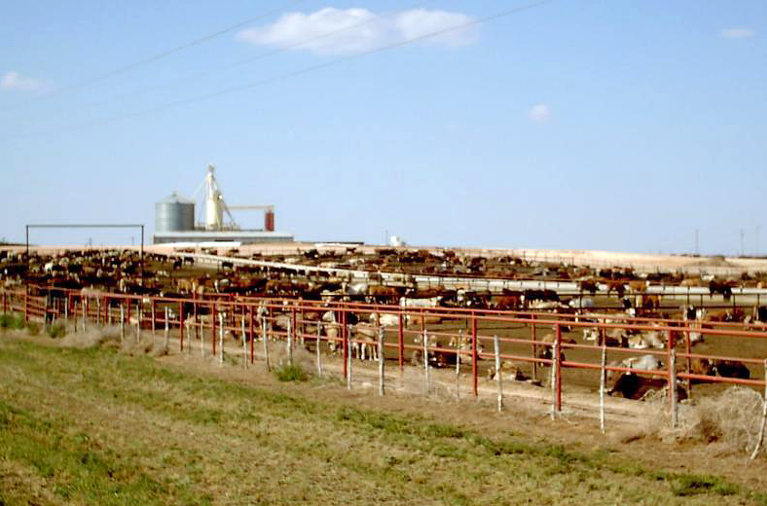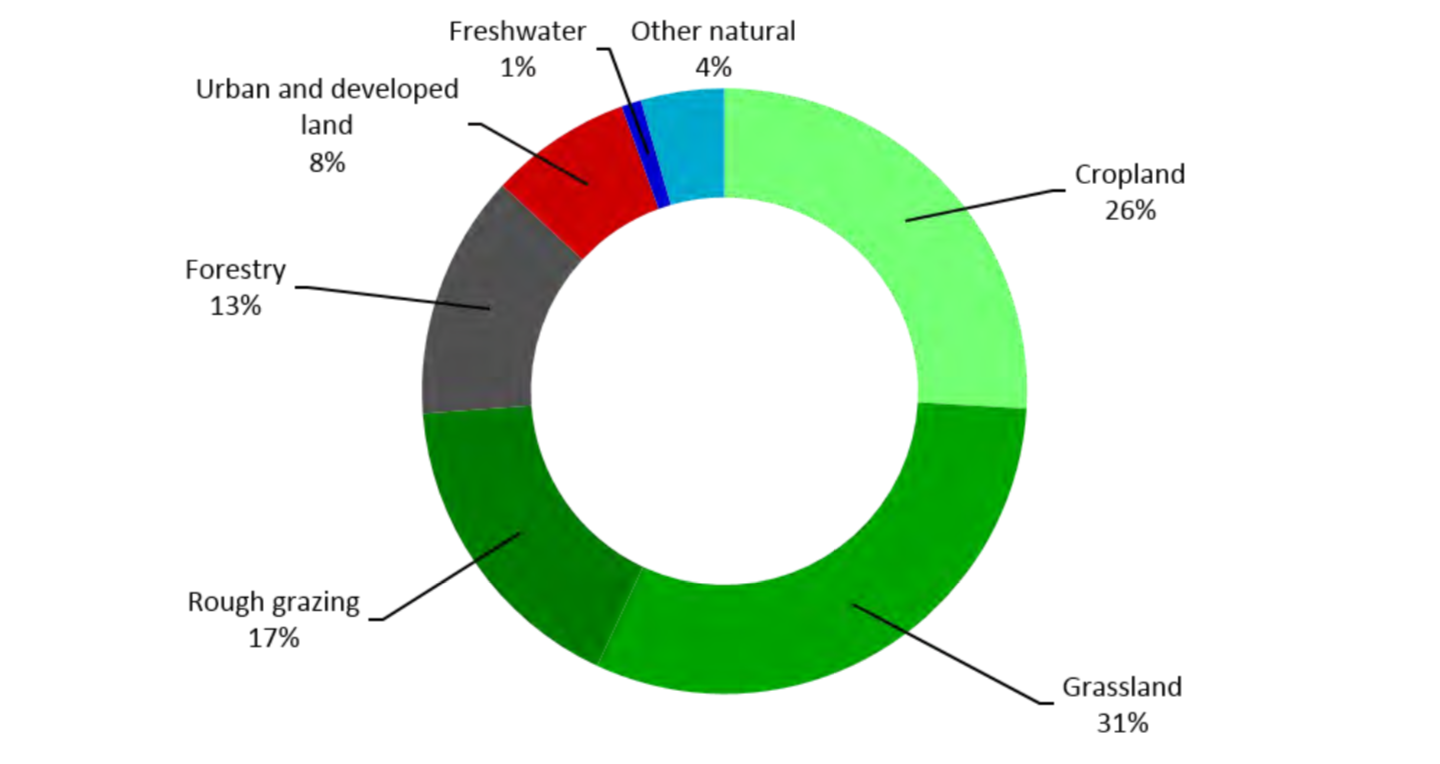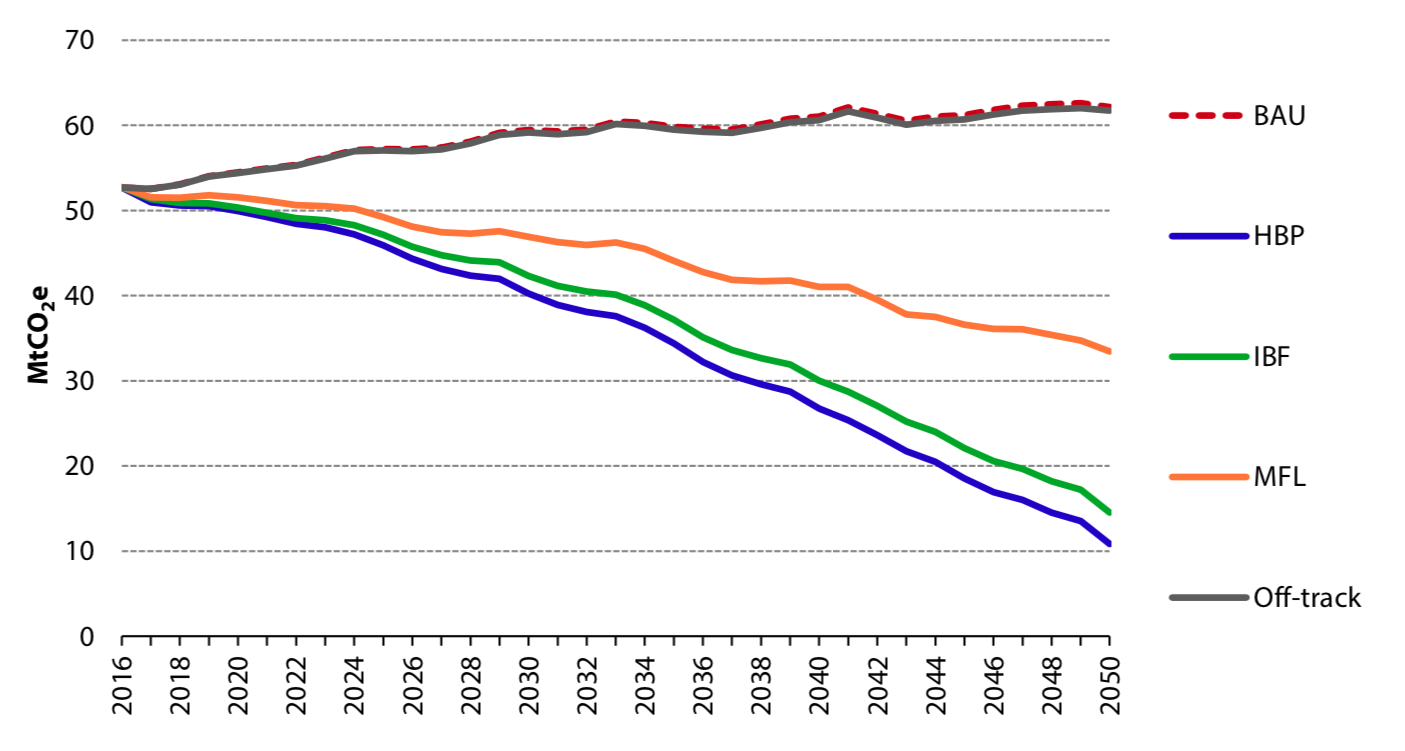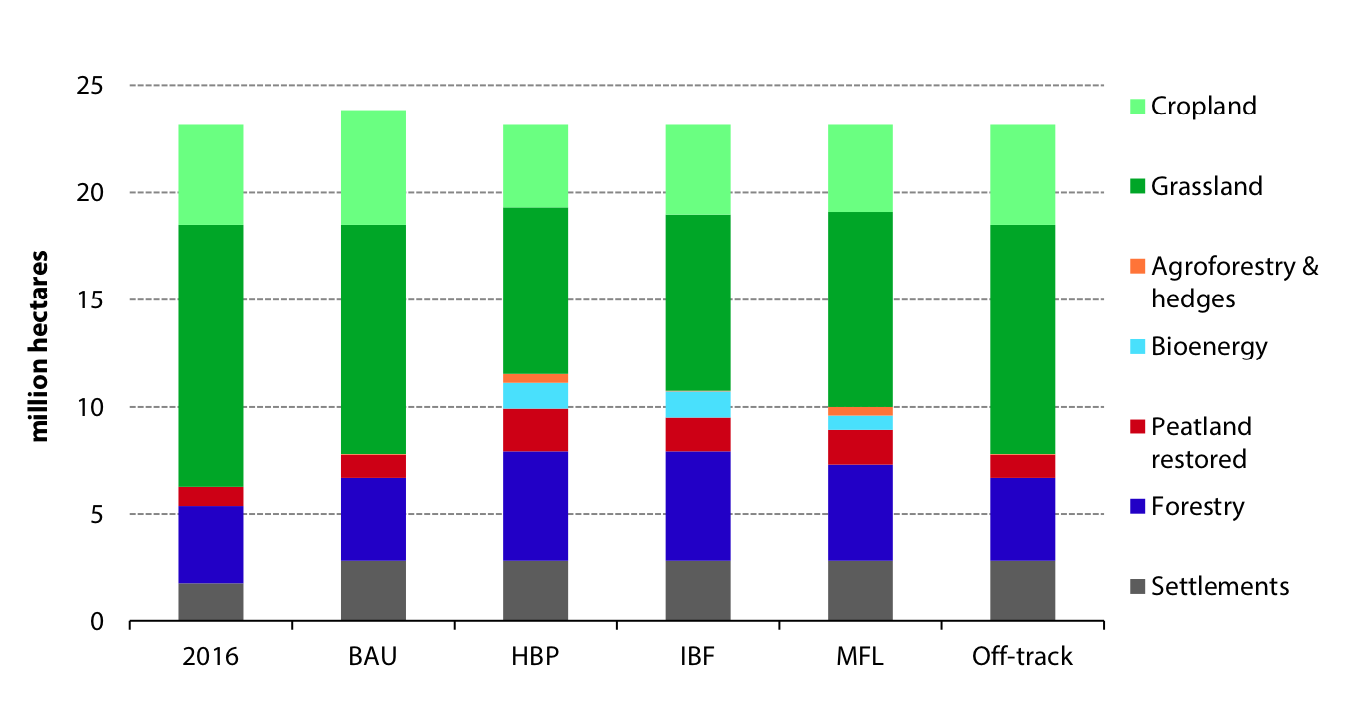Greenhouse gas emissions from the land-use and agriculture sector are set to increase unless the UK’s “unsustainable” approach changes, warns the Committee on Climate Change (CCC) in a report published recently.
“Fundamental reform” is needed to ensure the UK stores more carbon in land, says the government’s official climate advisory body.
Maintaining current per-capita food production will also become difficult, while farmers need help to deal with the impacts of a warming climate, it adds.
The new report considers how changes in land use can contribute towards mitigating and adapting to climate change. It says land-use emissions could be cut by 35-80% by 2050, compared with 2016 levels, while maintaining current per-capita food production.
“Land use is going to have to change very urgently if we are going to meet our climate change demands,” Lord Deben, chair of the CCC, tells Carbon Brief. “This is a time of radical change, close to revolution.”
Land emissions
Greenhouse gas emissions from the agricultural and land sector sat at 53 million tonnes of CO2 equivalent (MtCO2e) in 2016, 11% of the UK total. The main sources are nitrous oxide (N2O) and methane (CH4) from soils and livestock, followed by peatland emissions.
While agriculture emissions are currently far lower than for transport and energy supply, the sector is currently likely to be one of the largest emitters by 2050, the CCC says.
Land is also an essential resource for tackling climate change, the CCC says, through its ability to sequester and store carbon. For example, the 18MtCO2 per year currently emitted by peatlands could be reduced to 7-14MtCO2e by increasing the area being restored to 55-70%, up from 25% today, it says.
But past and current policies have rewarded food production over other services provided by land, the CCC adds. Agricultural emissions have barely changed over the last decade.
Critical asset
Land provides the “fundamentals of life”, the CCC says, offering ecosystem services, such as clean water, food, construction materials (timber), flood protection, healthy soils and wildlife. It also provides cultural services, such as education and recreation.
These are threatened by climate change, it says. Average UK temperatures have risen by 0.8C over the past 40 years, with climate impacts already altering land and degrading ecosystem services.
For example, a decline in spring-frost frequency has been linked with a reduced variation in blackcurrant yields compared to the 1960s and 1970s, the report says. The average arrival of spring over the past two decades is now six days earlier than in the first half of this century, it points out. Lord Deben, chair of the CCC, tells Carbon Brief:
“We have a fundamental change which climate change itself has caused…You see the serious beginnings of disruption, through climate change, of the mechanisms upon which farmers depends – the fundamental mechanism, which is pollination.”
In addition, intensive food production has driven a loss of soil fertility, biodiversity and peatland degradation, the report says.
The UK now urgently needs to manage land more effectively as the climate warms or risk losing its essential functions, the CCC says. It adds:
“Projections of future UK climate suggest further warming, sea level rise, periods of heavier rain leading to greater risks from flooding as well as reduced water availability in summer. Despite some opportunities, the negative impacts on our soils, water, vegetation and wildlife are likely to be significant.”
‘Fragmented’ policies
The European Union’s Common Agricultural Policy (CAP) and its predecessors have provided the main strategic framework for agriculture in the UK since the mid-1940s, the CCC says, and was designed to encourage farmers to produce more food. However, this will “have to change”, says Lord Deben:
“It has resulted certainly in very considerable productivity gains. But it has also resulted, through monoculture and in the way that we now have industrial farming, with soil that is significantly degraded and which is not capable of sequestering the carbon that we need to have sequestrated.”
The UK currently has an important opportunity to set a better land strategy that fully responds to climate change, the CCC says. As the UK exits the EU, new laws on agriculture and the environment – including the forthcoming Agriculture Bill and the proposed Environment Bill – mean there is currently a “one-off opportunity” to define how land is used for decades to come.
However, at the moment the Agriculture Bill has “very little precision”, with “few particularities within it”, says Lord Deben. The CCC adds:
“This is an important moment to influence the design of a set of policies that have been largely out of scope for decades. It is essential that the key objectives of the Climate Change Act: achieving deep emissions reduction; and adapting to the impact of a changing climate, are at the heart of reforms.”
New land-use policy must promote “radically different” uses of UK land to reduce emissions and improve resilience against climate change, the CCC says. This includes more tree planting, better forest management, restoration of peatlands and shifts to low-carbon farming practices.
Land-use emissions could be reduced from 53MtCO2e in 2016 to 11-33MtCO2e by 2050, while maintaining current per-capita food production, the CCC says. This would require reductions across agriculture, forestry, biomass, agro-forestry and peatlands.
Measures would include increasing forest cover from 13% of UK land today to 19% by 2050, restoring 55-70% of peatlands and “catchment-sensitive” farming.
Improved farming practices within the current pattern of land use, such as better soil and livestock management, could also offer “some emissions reductions”, the CCC says. But this would still leave agriculture as one of the biggest emitting sectors.
Scenarios
Agriculture – including land used for crops, livestock and grassland – currently uses 74% of the UK’s land area, as the chart below from the CCC shows.
A further 13% is “semi-natural” land, covering forestry, freshwater and other natural land, such as mountains and coastal margins. The remaining 8% is urban and developed land.
Current land use in the UK. Source: CCC estimates based on Agriculture in the UK, 2017, ONS Experimental physical assets accounts for the UK and 2015 Corine land cover map data. CCC 2018
The CCC highlights the importance to climate goals of freeing up land for afforestation and peatland restoration, as well as biomass production (with the caveat that environmental risks are managed). [The CCC has also released a report on biomass sustainability, covered by Carbon Brief.]
It finds a move towards healthier diets and improving agricultural productivity would have the biggest impact.
The CCC sets out five scenarios for how the distribution of land among agriculture, forestry and peatlands could be changed up to 2050.
The scenarios are:
- Innovation and behaviour focus (IBF) – Maximum ambition for agriculture innovation and high levels of change in behaviour towards healthy eating guidelines releases agricultural land for other uses such as tree planting.
- Multi-functional land use (MFLU) – Medium levels of ambition on innovation and behaviour change. High levels of hedgerows and trees on farms and areas of afforestation leading to a more diverse agricultural landscape.
- High biomass/natural peatland (HBP) – Higher agricultural productivity and some changes in behaviour on diets releases agricultural land, which is largely used for tree and bioenergy crops planting. Focus on peatland restoration also high.
- Off-track – Land spared through higher agricultural productivity and technology used mainly for growing more food, with a focus on maximising agriculture output and exports and low ambition on afforestation and bioenergy.
- Business as usual (BAU) – Existing trends in land use and management continue to 2050, with little change in behaviour on diets and food waste. Emissions increase by 9.5 MtCO2e by 2050 compared with 2016 levels.
The chart below shows the emissions resulting from each of these five scenarios.
GHG emissions for different land use scenarios from 2016 to 2050. Scenarios are: innovation and behaviour focus (IBF), multi-functional land use (MFLU), high biomass/natural peatland (HBP), off-track and business as usual (BAU). Source: CCC 2018.
Chris Stark, chief executive of the CCC, tells Carbon Brief:
“We think we have a set of credible, but still very difficult to achieve scenarios here. And from that we’ve drawn our conclusions. They look at the kind of extremes, I suppose, of what is possible. All of those assumptions have been run past the farming community and other land managers.”
The use of land in the UK in 2050 in each of the scenarios in 2050 is shown in the chart below.
Land use in 2016 and under alternative scenarios by 2050. Source: CE Hand Rothamsted Research (2018) and CCC analysis. CCC 2018.
Meat consumption
Many beneficial changes to land use would fit in with the government’s wider goals in other areas, the CCC says. For example, a shift in diets towards nutritional guidelines would improve health at the same time as reducing production of the most carbon-intensive foods and releasing large tracts of land for other uses, says the CCC. It notes:
“The production of beef, lamb and milk is a large source of agricultural emissions in the UK. In 2016, cattle and sheep directly accounted for around 58% of agriculture emissions, while there are additional soil emissions associated with growing their feed (eg grass and cereals).”
Lord Deben tells Carbon Brief:
“What we need is to have less and better meat consumption from farms who are caring about the future of their land. [That is absolutely] central and essential to dealing with these matters.”
Reducing food waste is also important, the CCC says. However, this would free up less land than for reduced meat consumption, since products which tends to make up food waste, such as vegetables, salads and drinks, do not use up much UK land area, the CCC says. For instance, 84% of the UK’s fruit demand was imported in 2017.
What’s next
Today’s report is the first of two CCC reports on land-use. A second report next year will focus on how land-use policies can be used to mitigate climate change and inform the development of the government’s new land-management system.
In the meantime, the CCC has given two main recommendations in its report today for how policy on land-use should be developed.
First, it says that new land-use policy needs to reward landowners for “public goods” that deliver climate mitigation and adaptation, such as peatland restoration and reducing flood risks.
Second, the government needs to support land managers as they transition to alternative land uses. For example, they will need help with new skills and training, as well as with high up-front costs which could lead to a loss of income, such as when switching to a new kind of crop. “There is no farmer alive today who has worked under any other system than the system of production support,” Lord Deben says.
They also need a structured approach allowing for the potential impacts from a changing climate in their future planning. The CCC says the government should support this through its National Adaptation Programme or the new Environmental Land Management System.
Teaser photo credit: By H2O – own picture/copied from en:Image:Feedlot-1.JPG, CC BY-SA 3.0








